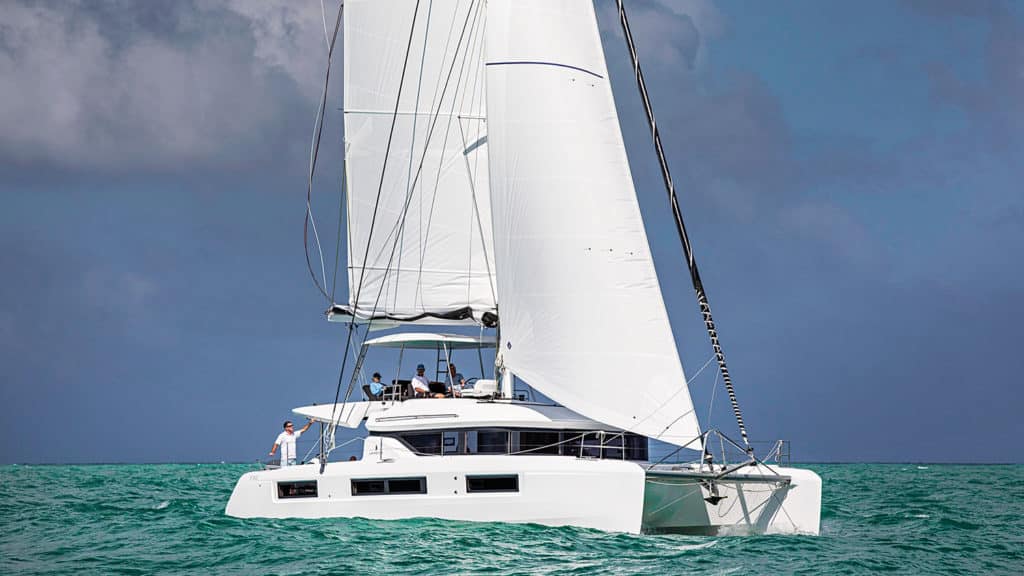
At a press event during the Miami International Boat Show last winter, the Lagoon 50 was described by a company spokeswoman as being “the most open-minded catamaran on the market.” That’s a statement that could be taken in a number of ways.
First, there are the multiple social areas encompassed by the boat’s 48-foot-5-inch LOA and 26-foot-7-inch beam. There are dining tables indoors and out, lounge areas astern and forward. Overhead, the flybridge offers more room to gather or get away. The crew could sunbathe on cushions that store in a locker built into the Bimini, or take a seat by the wheel and help out with the sailing, though, to be honest, with autopilot, a self-tacking jib and electric winches at your fingertips, it’s possible to keep things simple. Then again, roll out the optional genoa and sheet it home, and things can get sporty, real quick.
We tried a little of both in some breeze after the show. With a reef in the main and the self-tending jib trimmed home, coming about required turning the wheel and adjusting the traveler using the nearby electric Harken line drive.
Later, with the big (optional) headsail set, well, I was happy to have a couple of extra sets of hands to help sort out steering, blowing one sheet and trimming the other, and keeping track of the high-aspect square-top main. For the record, beating in about 15 knots of breeze, the speedo ranged from 5.6 to 6.2 knots; with the genoa unfurled and on a reach, the GPS read 9 knots and change.
Open-minded could also refer to the range of layouts available. The cat we sailed featured an owners suite in the starboard hull with an island-style double berth aft, a head with separate shower in the bow and a walk-in dressing room inboard and just forward of the companionway to the saloon. Portside, there were cabins fore and aft with en-suite separate head and shower. Instead of a dressing room, there was a cavernous storage space inboard. If desired, the port heads could be reconfigured to create three single-stall heads with showers, and the storage space could be transformed into another double cabin. And if an owner chose to forgo a master suite, a six-cabin, six-head layout is also available, though to me, 12 crew even on a 50-footer seems tight.
All that room for variation below translated into abundant living space above. Stepping aboard from the optional fold-down swim and tender platform, a long couch spanned the transom, with storage on the port end and a barbecue on the other that can be spun around so you can cook either from the cockpit or transom stairs. A teak table was forward to port, located nearby the L-shaped galley just inside the saloon. With both its leaves open, the table seats 12. Opposite was a cushioned couch alongside a fridge, ice maker and sink.
Entering the saloon, you step into the cook’s domain, with L-shaped Corian counters to either side of the sliding glass door. To port, there was sink, cooktop, oven and microwave; to starboard sat a fridge, freezer and storage. Ahead, an island offered yet more locker and counter space, and it served as a transition to a raised living area that was a step higher than the rest of the bridgedeck. A full-size nav station was to starboard. Forward of that, a U-shaped couch wrapped around the front of the saloon. In the center, there was a clever table arrangement: Upright, it was for dining; tipped aft and lowered on its hinged legs, it rested against the island (which also housed a retractable flat-screen TV) and became a place to set cocktails or popcorn on movie night.
There was yet more seating on the foredeck, where another U-shaped couch (forward-facing this time) surrounded another small table. The builder designed the center saloon window so it lowered to let in the breeze or so crew inside and out could converse.
The 50 comes standard with a pair of 57 hp Yanmars. The boat we sailed was powered with optional 80 hp Yanmars. The option list included a number of other upgrades, including an 11 kW Onan genset, which brought the price tag to just about 1.07 million euros (roughly $1.32 million, depending on currency fluctuations).
Lagoon has bigger boats in its range, but they’re designed with a captain and crew in mind. The 50 is meant for the owner and mates who’ve outgrown their 45-footer but still want to go off voyaging on their own, and can do so thanks to a networked plotter and autopilot, a bow thruster, a self-tacking jib and power winches. When it comes down to what’s possible, it pays to keep an open mind.
Mark Pillsbury is CW’s editor.








